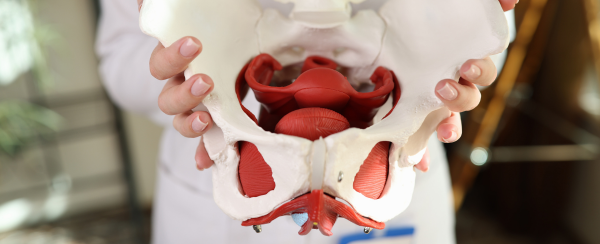During surgery, the area being treated is often exposed to the external environment. Great care is taken to create a sterile environment to prevent anything, including bacteria and other microbes not naturally found in the body, from entering the body. This is crucial to help prevent infections during the healing process. But how can we prevent infection if the part of the body undergoing surgery has a natural microbial environment?
Advancing Health Scientist and urogynecologist Dr. Roxana Geoffrion, who works at the Centre for Pelvic Floor at St. Paul’s Hospital, specializes in pelvic reconstructive surgeries. These operations occur either near or within the vaginal canal, where sustaining a natural microbiome is vital to maintaining a healthy environment. These surgeries are classified as clean-contaminated surgeries due to their proximity to an area where bacteria naturally live and come with an increased risk of post-surgery infection, particularly urinary tract infections (UTIs). Dr. Kiran Mann, an obstetrics and gynecology resident who worked with Dr. Geoffrion, led research evaluating the impact of a bundle of interventions designed to prevent infections after pelvic reconstructive surgery. Remarkably, this bundle strategy decreased the rate of UTIs after surgery by more than half!
“It was exciting to see how big an impact our bundle had for patients after their pelvic reconstructive surgery,” says Dr. Mann. “Many of our patients are older in age and post-menopausal, both of which increase their UTI risk, so knowing our bundle can make such an impact to decrease infection risk is a game-changer.”
There is emphasis to prevent infection after clean-contaminated surgeries because bacteria will be living and growing in the area which is healing. Examples of clean-contaminated surgeries are surgeries of the respiratory, gastrointestinal or genitourinary tract, which occur without breaking sterile technique. In contrast, an example of contaminated surgery would be a bowel operation during which bowel contents spill into the wound, whereas a clean surgery, which is a completely sterile operation, would be brain surgery. There is a higher risk of infection after clean-contaminated and “dirtier” surgeries, so additional measures need to be taken to mitigate that risk. This is where implementing a surgery care bundle comes in.

Preventing post-surgery infection
The surgical categories of cleanliness arose because each one of them is associated with a goal for a post-operative complication of infection. “Typically, you would want an infection rate of 10 per cent or less for clean-contaminated surgeries. It is expected that the infection rate will steadily go up from clean to clean-contaminated to contaminated surgeries,” said Dr. Geoffrion. “Being immunocompromised, older, or other factors can also increase the risk of infection. Introducing a bundle to reduce infection rates could help all of these patients.”
“A patient care bundle combines multiple evidence-based interventions together to reduce infection rates,” explained Dr. Mann. “The intention is to achieve a greater impact through the bundle than by applying just one intervention.”
Patient care bundles are a recently adopted approach to decrease infection rates after surgery. They are starting to be used in surgeries designated as clean-contaminated and in more contaminated surgical scenarios. In Drs. Mann and Geoffrion’s study, the goal was to attempt to reduce post-operative urinary tract infections after reconstructive pelvic surgery, with the bundle having the following three components: A UTI check in the week before surgery, with oral antibiotic treatment if needed; next day discharge with a catheter for another 24 hours instead of frequent catheterizations on the hospital ward; and daily cranberry extract for six weeks after surgery.
The first component emphasizes the importance of having a clean area to perform surgery on. Checking for a UTI prior to surgery provides the opportunity to treat the infection before the operation, which helps to decrease patient suffering and recovery time after surgery.
The bundle also sought to enable patients to return home the morning after their surgery, rather than the usual couple of days later. This became especially pertinent during the COVID-19 pandemic. “Restrictions were being placed on elective surgeries,” shared Dr. Geoffrion. “It motivated our team to find ways to discharge patients sooner to be able to have more patients go through the surgical system in addition to receiving their operations in a timely manner.”
For this study, before heading home, nursing staff would place a catheter in the patient’s bladder, provide them with the attached bag for urine collection, and instructions on how to empty or change the bag. The catheter was then removed the following day by a nurse continence advisor without the patient having to spend an additional night in the hospital. Study participant Mairéad Smith, whose real name has been changed to maintain anonymity, shared her experience going home with a catheter: “I was sent home with the catheter, and I was very glad to have the support of my husband. I was having trouble bending over so he would help me adjust it so that I could be more comfortable. It ended up being a really intimate interaction.”
The final component of the bundle involved patients taking cranberry extracts daily over six weeks. As cranberry extract concentrations differ from brand to brand, specific instructions were given as to how to procure a sufficient dose for infection prevention. When asked about how patients felt about taking supplements this frequently, the response was overwhelmingly positive. “It was universal yes from all of our participants,” shared Dr. Geoffrion. “Patients just loved taking the cranberry pills after their operation. They don’t have any side effects, plus cranberries were familiar to our patients. They are readily recognized as having health benefits, so our cranberry extract intervention was perceived very positively.”
“I had written instructions and was faithfully taking the cranberry pills,” emphasized Mairéad. “I found it very easy to incorporate pills into my everyday routine because I just added it in my box where I keep my daily regimen of supplements.”

Impact of study findings
One of the most interesting findings comes to light when comparing the average ages of patients in the two study groups. The patients who received the bundle were on average five years older than those who did not; however, they still had a lower rate of post-surgery infection. “The fact that the UTI rate was so much lower despite the bundle cohort being older is very significant because they are more prone to recurrent bladder infections,” said Dr. Geoffrion. It is also important to highlight that the UTI rate for this study was 6.5 per cent, which is below the lower end of what is reported in other scientific studies, which ranges from 7-34 per cent.
Mairéad shared her positive experience, “I’m very happy to report back on the operation and that my toosh is working well. One year after the operation, I’m so happy I had it! I wish more women knew about pelvic reconstructive surgery.”
Being able to wear the catheter home after the surgery also meant that Mairéad was able to leave the hospital earlier. This increases the overall number of patients able to receive the surgery because there are beds available sooner.
There is also significant potential for the results collected from this single-center study to be applied to other surgeries with similar and “dirtier” cleanliness designations. For example, checking for infections prior to conducting surgery would ensure that the area being worked on has the best possible chance of healing well. This is especially important when performing surgery in patients who are more susceptible to infections, whether it be because of age, or living with an immunocompromised condition or co-morbidity. It is important to note that although this study was done in a single surgical center, these results are representative of the entire breadth of pelvic reconstructive surgeries.
Moving forward
The significant impact of this bundle warrants its implementation in other practices. Drs. Mann and Geoffrion emphasize that the key to expanding this bundle protocol is standardization. For example, having a preoperative checklist which includes the bundle, and training surgeons and nurses on what implementing the bundle involves. An important component that might be more challenging to implement is the preoperative universal urinary tract infection check, as it does use additional health care resources for an elective surgery. However, considering the significant decrease in post-surgery UTIs, the initial cost of screening for UTIs prior to surgery may ultimately cost fewer resources as there would be fewer post-surgery infections overall. This bundle can also be used for various other clean contaminated surgeries as well, including colorectal surgery patients.
“Bundles to decrease infection rates are often used in other surgical specialties,” said Dr. Mann. “But the key to success is getting whole teams on board.” For example, studies where bundles significantly decreased infections after colorectal and gynecological oncology procedures emphasized the importance of educating the multidisciplinary team. Many urogynecologists across BC have adopted the cranberry handout for their own patients and have implemented same-day or next-day discharge successfully.
Dr. Geoffrion also highlights another concern with pelvic floor disorders, “I think we’re running into issues with awareness because these are pelvic floor disorders, concerning women who are older and have traditionally kept quite silent about their symptoms and don’t really want to bring them to the forefront, because they feel vulnerable or private.” This sentiment is echoed by the anonymous patient who preferred not to share her identity despite her positive surgical experience.
“Anything that we can do to decrease patient morbidity in the post-operative period is extremely, extremely crucial for recovery,” concluded Dr. Mann. “Especially in this vulnerable population who may have suffered for many years. Optimizing the post-operative recovery period is something that we’re very enthusiastic about and we’re pleased that we can share our results to support how beneficial taking care of the patient both before and after the surgery can be to their recovery.” The team are hopeful that these results can be applied to other surgical procedures and lead to practice changes and better patient outcomes across the board.
Interested in implementing this bundle within your practice? Contact Dr. Geoffrion at rgeoffrion at providencehealth.bc.ca for further guidance.
For more information, and a whiteboard animation video designed for patients, check out the researchers’ website at www.bepelvichealthaware.ca. Feel free to connect with them on Instagram and Facebook.



